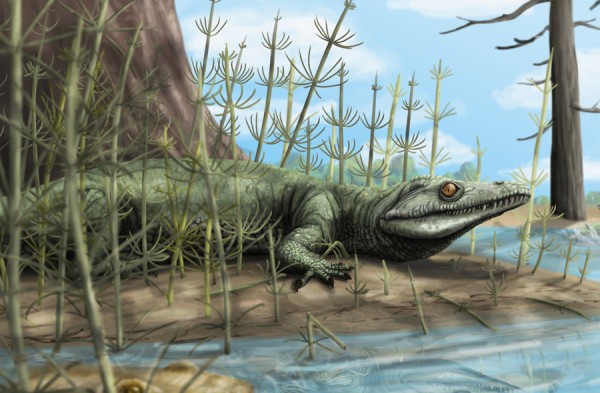By Ana Verayo, | March 13, 2016

The 250 million year old Teyajugua reptile is a precursor to dinosaurs.
Scientists uncovered an ancient skull dating back from 250 million years from the southern regions of Brazil, that can help researchers to gain a better understanding of how life transpired before dinosaurs ruled the world.
Now, an international team of scientists from Brazil and the United Kingdom reveals that this skull belongs to a Teyujagua paradoxa which is a small quadruped measuring just under five feet in length, that possesses unique nostrils that can reach up to its snout including sharp teeth that are similar to crocodiles.
Like Us on Facebook
Their sharp teeth also appears to be pointed which suggest that this creature was a carnivore that consumed amphibians and smaller reptiles as part of its diet.
However, scientists are more concerned about the fossil's age, as it was also found in the state of Rio Grande do Sul near São Francisco de Assis . This skull dates back to 250 million years old, which means that this animal existed during an epoch where the Permian-Triassic mass extinction event occurred. This event which is also known as "The Great Dying" involves 90 percent of all living species being wiped out some 252 million years ago, due to reasons that are still not yet confirmed.
This newly discovered fossil can also provide new information about ancient ecosystems during that time and how animal life recovered from this disaster. These new findings can also determine the group of animals that evolved into dinsoaurs, birds, crocodiles and pterosaurs, linking them to the evolution of large terrestrial animals.
According to co-author of the study, Richard Butler from the University of Birmingham's School of Geography, Earth and Environmental Sciences, the Teyujagua is truly a pivotal discovery since it can help with the understanding of the origins of this group of vertebrates known as archosauriforms.
Butler says that archosauriforms are incredibly diverse that can consist of almost all kinds of animals such as hummingbirds to crocodiles and giant dinosaurs like the Tyrannosaurus rex and Brachiosaurus. This discovery of the Teyujagua also fills an evolutionary gap that was existing between archosauriforms and more primitive reptiles. This can also help in further understanding of the evolution of the archosauriform skull.
This archaic reptile's name derives from the Guarani language originally from South America, where Teyujagua is translated to "fierce lizard", that also possessed references to a mythological creature that is described as a lizard with a dog's head.
This new study is published in the journal Scientific Reports.
-
Use of Coronavirus Pandemic Drones Raises Privacy Concerns: Drones Spread Fear, Local Officials Say

-
Coronavirus Hampers The Delivery Of Lockheed Martin F-35 Stealth Fighters For 2020

-
Instagram Speeds Up Plans to Add Account Memorialization Feature Due to COVID-19 Deaths

-
NASA: Perseverance Plans to Bring 'Mars Rock' to Earth in 2031

-
600 Dead And 3,000 In The Hospital as Iranians Believed Drinking High-Concentrations of Alcohol Can Cure The Coronavirus

-
600 Dead And 3,000 In The Hospital as Iranians Believed Drinking High-Concentrations of Alcohol Can Cure The Coronavirus

-
COVID-19: Doctors, Nurses Use Virtual Reality to Learn New Skills in Treating Coronavirus Patients







